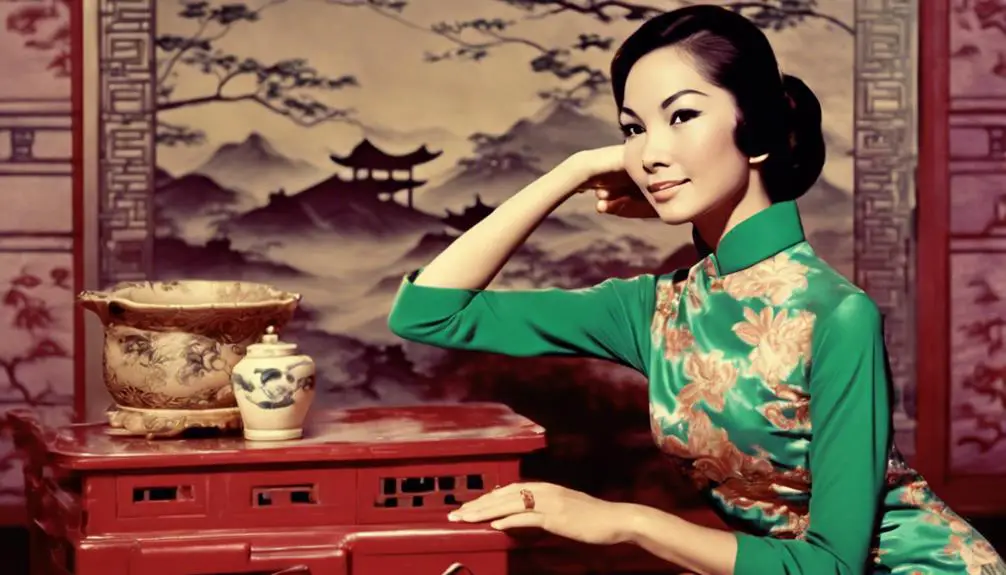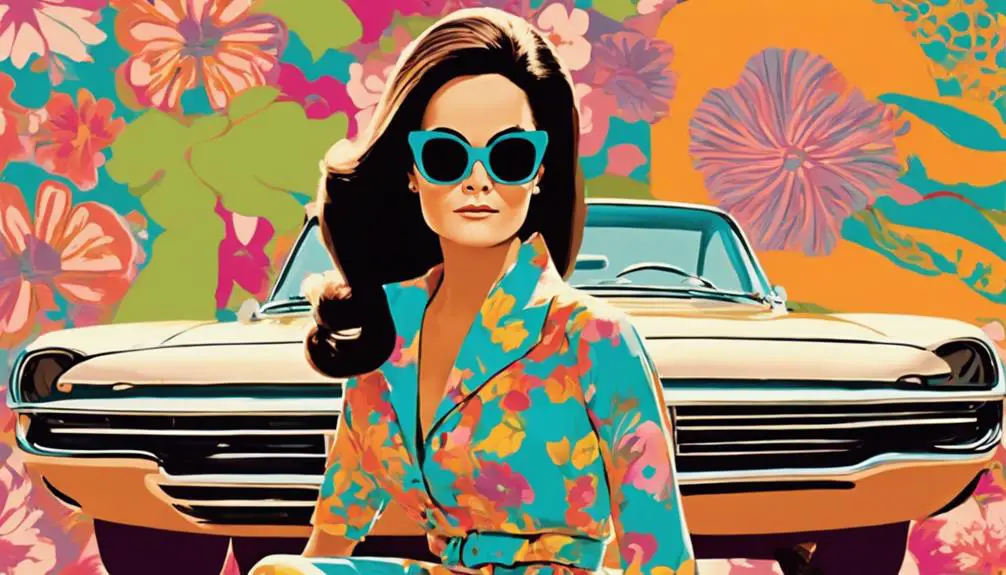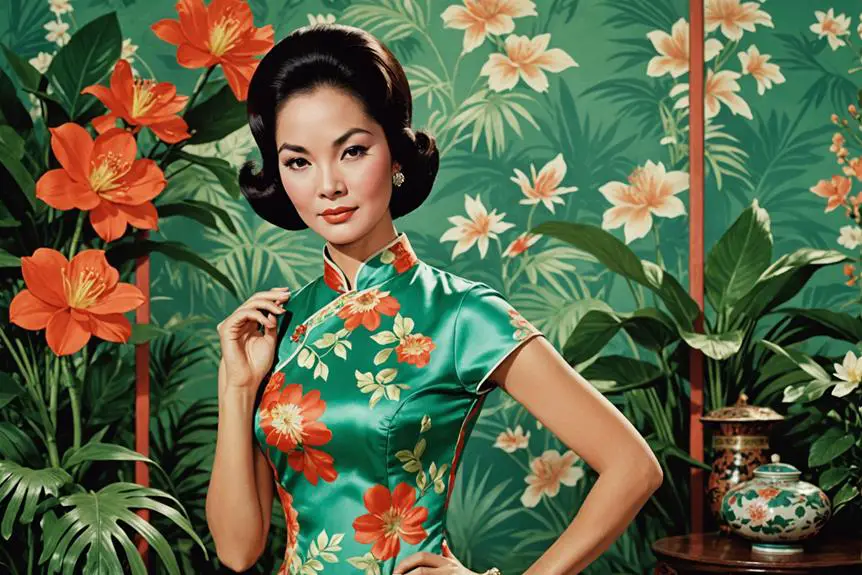When you think about the evolution of Asian femininity in fashion, Nancy Kwan's contributions can't be overlooked. Her portrayal of the cheongsam in "The World of Suzie Wong" marked a turning point, transforming a traditional garment into an emblem of modern elegance. The "Suzie Wong dress," along with her groundbreaking hairstyle, the "Kwan cut," not only shaped beauty standards but also sparked conversations about cultural representation in fashion. As you explore her style, you might find yourself questioning how her influence persists in today's fashion landscape. What elements of her legacy still resonate?
Early Life and Background

Nancy Kwan's early life laid the groundwork for her future as a fashion icon and actress. Born in Hong Kong on May 19, 1939, Kwan grew up in an affluent environment, shaped by her Cantonese architect father and European model mother.
However, her childhood was disrupted by the Japanese invasion during World War II, forcing her to flee to North China with her father and brother. After her parents divorced when she was just two, Kwan was raised by her father and stepmother, alongside five half-siblings, and attended the Catholic Maryknoll Convent School until she turned 13.
Kwan's passion for the performing arts blossomed early, particularly in ballet. This interest led her to study at the prestigious Royal Ballet School in London at 18, where she honed her skills and developed a unique style.
It was during this time that she began auditioning for roles, ultimately catching the eye of producer Ray Stark. Her determination paid off when she landed her breakthrough role, setting the stage for her illustrious career in film and fashion.
Kwan's rich background and experiences prepared her for the spotlight, making her a true icon.
Breakthrough Role in Film
With her breakthrough role in "The World of Suzie Wong" (1960), Kwan captured the hearts of audiences and critics alike. As the lead actress portraying Suzie Wong, she showcased her remarkable talent and unique beauty, quickly becoming a sensation in Hollywood.
The film premiered at Radio City Music Hall and turned into a box office hit, elevating Kwan's status and visibility in an industry that often sidelined Asian roles. Her enchanting performance earned her a Golden Globe nomination for Best Actress – Drama, marking a pivotal moment in cultural representation for Asian actresses in mainstream cinema.
Kwan's role didn't just highlight her acting abilities; it sparked essential discussions about how Asian women were depicted in film, challenging stereotypes and paving the way for future talent.
The success of "The World of Suzie Wong" opened doors for Nancy Kwan and other Asian actors, encouraging Hollywood to embrace more diverse narratives and characters.
As you reflect on her impact, consider how her iconic role has left an indelible mark on the industry, inspiring generations of performers and audiences alike to appreciate the beauty of varied cultural representation.
Iconic Fashion Styles

The world of fashion took a notable turn in the 1960s with the emergence of Nancy Kwan as a style icon. Her influence reached far and wide, especially with her stunning portrayal of Asian femininity through the iconic cheongsam. The "Suzie Wong dress," a beautifully tailored qipao, not only became a symbol of beauty but also redefined how traditional garments were viewed in a modern context.
When Kwan graced the cover of Life magazine in October 1960, she propelled the qipao into mainstream fashion, showcasing its elegance and versatility.
Adding another layer to her fashion legacy, Kwan's "Kwan cut," created by the legendary Vidal Sassoon, revolutionized hairstyling for women in the 1960s. This chic, sharp style complemented her outfits perfectly and became a sought-after look for many.
In her role in "Flower Drum Song," Kwan dazzled audiences with vibrant traditional attire, further solidifying her status as a fashion icon. Through her remarkable ability to merge Western styles with traditional elements, Nancy Kwan inspired a generation of designers, making her an enduring figure in the world of fashion.
Cultural Impact and Representation
Kwan's influence extended far beyond fashion, igniting essential conversations about cultural representation in Hollywood. Her groundbreaking roles in films like "The World of Suzie Wong" challenged the stereotypes often associated with Asian characters, showcasing a more nuanced portrayal of Asian women. With her iconic image in a cheongsam, she didn't just become a sex symbol; she also set fashion trends that resonated deeply in popular culture.
Kwan's work in "Flower Drum Song," featuring an all-Asian cast, was revolutionary, as it tackled cultural sensitivities and aimed to reshape how Asian stories were told in mainstream cinema. This film not only highlighted diverse roles for Asian actors but also advocated for a shift in Hollywood's approach to casting and storytelling.
As a pioneering figure, Nancy Kwan opened doors for future generations, inspiring more complex and authentic representations of Asian characters in film. Through her advocacy, she helped pave the way for a gradual shift toward inclusivity, making it possible for Asian actresses to find more diverse opportunities.
Kwan's legacy is a reminder of the importance of representation in shaping the narratives we see on screen, and her impact continues to resonate today.
Later Career Highlights

Kwan's iconic hairstyle, famously known as the "Kwan Cut," created by the legendary Vidal Sassoon, became a defining fashion moment of the 1960s, influencing countless trends.
In the 1970s, she displayed her entrepreneurial spirit by founding "Nancy Kwan Films," focusing on producing content tailored for the Southeast Asian market, demonstrating her commitment to representation.
Beyond acting, Kwan embraced philanthropy, particularly in AIDS awareness, which highlighted her compassionate nature.
Her book, "A Celebration of Life: Memories of My Son," further showcased her depth beyond the silver screen.
Through these endeavors, Nancy Kwan not only left a lasting impression in fashion and acting but also solidified her legacy as a multifaceted artist dedicated to her craft and community.
Legacy and Influence
Impact and inspiration define Nancy Kwan's legacy, which resonates through fashion and film even today.
As a fashion icon, Kwan's portrayal in "The World of Suzie Wong" didn't just popularize the cheongsam; it transformed it into a symbol of Asian femininity and elegance in Western fashion. This influence considerably shaped 1960s trends, showcasing how clothing can carry cultural significance.
Her iconic "Kwan Cut," created by Vidal Sassoon for "The Wild Affair," further cemented her impact on beauty trends, influencing hairstyles for years to come.
When Kwan graced the cover of Life magazine in 1960, her stunning cheongsam attire solidified her status as a fashion icon, sparking global fascination with Asian aesthetics.
Beyond fashion, Kwan's advocacy for improved Hollywood representation of Asian actresses challenged stereotypes and encouraged a broader acceptance of Asian culture in mainstream cinema.
Her cultural impact continues to inspire contemporary Asian fashion designers and filmmakers, who draw from her groundbreaking style.
Nancy Kwan's legacy isn't just a reflection of her own achievements; it's a beacon for future generations, reminding us of the importance of diversity and representation in the arts.
Frequently Asked Questions
Why Is Nancy Kwan Famous?
Nancy Kwan's fame stems from her trailblazing roles in Hollywood, showcasing Asian beauty and cultural impact. She influenced fashion evolution and style inspiration, leaving a lasting legacy on representation in the film industry and fashion collaborations.
How Many Movies Did Nancy Kwan Make?
Nancy Kwan's filmography includes over 50 films, showcasing her breakthrough role in "The World of Suzie Wong." Her acting style and collaborations with directors left a lasting cultural impact, influencing fashion and inspiring future generations.
What Happened to Nancy Kwan's Son?
Imagine a rose wilting; that's what happened to Nancy Kwan's son. His battle with HIV transformed her family background, sparking her advocacy. Through life challenges, she honored his memory, shaping her future aspirations and public appearances.




